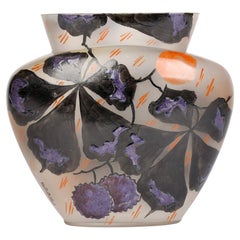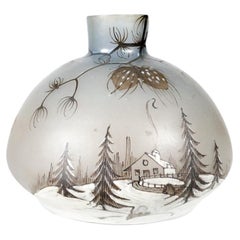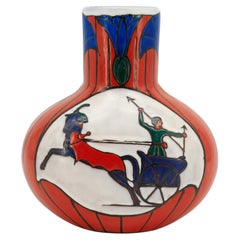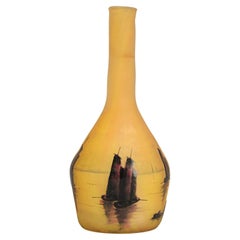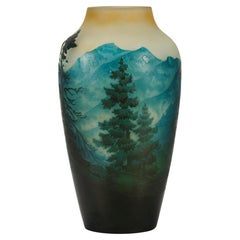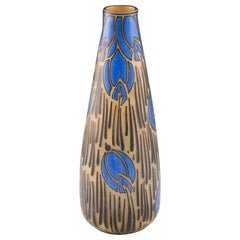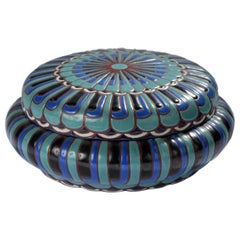Société Anonyme des Etablissements Leune Decorative Objects
to
1
3
3
2
1
1
1
2
1
3
2
3
3
3
Height
to
Width
to
3
3
3
5
1,351
747
489
478
Creator: Société Anonyme des Etablissements Leune
Leune French Art Deco Hand-Enameled Art Glass Vase with Chestnuts
By Société Anonyme des Etablissements Leune
Located in Bishop's Stortford, Hertfordshire
A fine French Art Deco glass vase hand-enameled art glass vase decorated with Chestnut stems and dating from around 1930. This stylish vase is molded in frosted glass and hand applie...
Category
1930s French Art Deco Vintage Société Anonyme des Etablissements Leune Decorative Objects
Materials
Art Glass
Art Nouveau Cameo Glass Vase by Leune, France, 20th Century
By Société Anonyme des Etablissements Leune
Located in Lisbon, PT
An early 20th-century Art Nouveau enameled cameo glass vase by Leune, inspired by the renowned works of the Daum brothers in Nancy, France.
This vase is decorated with a winter land...
Category
Early 20th Century French Art Nouveau Société Anonyme des Etablissements Leune Decorative Objects
Materials
Glass
$1,747 Sale Price
20% Off
LEUNE French Art Deco Enameled Glass Vase, 1920
By Société Anonyme des Etablissements Leune
Located in Saint-Amans-des-Cots, FR
French Art Deco glass vase by LEUNE, 28bis rue du Cardinal Lemoine, Paris, France, ca.1920. Fully and heavily enamelled glass gourd vase. Papyrus deco...
Category
1920s French Art Deco Vintage Société Anonyme des Etablissements Leune Decorative Objects
Materials
Art Glass
Related Items
Early 20th Century Art Nouveau Glass "Miniature Boating Vase" by Daum Frères
By Daum
Located in London, GB
"Miniature Boating Vase" by Daum Frères
A very fine early 20th Century miniature cameo glass vase etched etched with a scene of boats afloat on a sea landscape against a warm yellow...
Category
Early 20th Century French Art Nouveau Société Anonyme des Etablissements Leune Decorative Objects
Materials
Glass
$2,378
H 2.37 in W 1.19 in D 1.19 in
Early 20th Century French Art Nouveau Glass "Mountain Vase" by Emile Gallé
By Gallé
Located in London, GB
A stunning late 19th Century French cameo glass vase decorated with deep green conifer and mountainous backdrop in an attractive green and turquoise colour against a variegating yell...
Category
Early 20th Century French Art Nouveau Société Anonyme des Etablissements Leune Decorative Objects
Materials
Glass
$5,912
H 9.85 in W 5.52 in D 5.52 in
Art Nouveau Bohemian Glass Vase, Early 20th Century
Located in Roma, IT
Art Nouveau bohemian iridescent orange vase, realized in the early 20th Century.
Excellent condition.
Category
Early 20th Century Czech Société Anonyme des Etablissements Leune Decorative Objects
Materials
Glass
Galle Cameo Glass Art Nouveau Vase
Located in Tarry Town, NY
A lovely gourd shaped cameo glass vase in the Art Nouveau style featuring violet colored flowering berry vines on a yellow ground. 13 1/2 by 5 1/2 inches and in very good condition....
Category
20th Century Art Nouveau Société Anonyme des Etablissements Leune Decorative Objects
Materials
Art Glass
Emile Gallé French Art Nouveau Cameo Glass Vase
By Émile Gallé
Located in Antwerp, BE
Emille Galle (1846-1904).
Émile Gallé was a French glass maker and furniture designer, who had his home in his native Nancy. His favourite topic, which he frequently used in his wor...
Category
Early 1900s French Art Nouveau Antique Société Anonyme des Etablissements Leune Decorative Objects
Materials
Glass
Art Nouveau Glass Vase, Early 20th Century
Located in Roma, IT
Art Nouveau vase realized by French manufacture in the early 20th Century.
Very good condition.
Category
Early 20th Century French Art Nouveau Société Anonyme des Etablissements Leune Decorative Objects
Materials
Glass
Adrien Mazoyer Rare Art Deco Enameled Flower Vase, 1920
Located in Saint-Amans-des-Cots, FR
Rare Enameled Glass Vase by Adrien Mazoyer, Moulins, France, 1920s.
A stunning and rare enameled glass vase by Adrien Mazoyer (1887–1950), crafted in Moulins, France, during the vib...
Category
1920s French Art Deco Vintage Société Anonyme des Etablissements Leune Decorative Objects
Materials
Art Glass
Large Art Déco Enamel Vase 'Volants Et Dentelles', Camille Fauré, France 1925/30
By Camille Fauré
Located in Vienna, AT
Large ovoid copper vessel on a round, grooved base with a short, narrow neck constriction and flared rim, coated in silvery pink and decorated with iridescent enamel in the form of l...
Category
1920s French Art Deco Vintage Société Anonyme des Etablissements Leune Decorative Objects
Materials
Copper, Enamel
$8,052
H 12.01 in Dm 9.06 in
Daum Frères Art Deco Glass Vase, France 1920s
By Daum
Located in Bochum, NRW
Daum Nancy Art Deco Glass Vase, ball-shaped, resting on a round base, with a narrow, flared mouth.
This glass ball vase is made of orang...
Category
1920s French Art Deco Vintage Société Anonyme des Etablissements Leune Decorative Objects
Materials
Glass
Early 20th Century Art Nouveau Glass "Red Sunset Vase" by Daum Frères
By Daum
Located in London, GB
"Red Sunset Vase" by Daum Frères
A striking and unusual early 20th Century cameo glass vase enamel painted with a green forest landscape against a fiery yellow and orange field, Sig...
Category
Early 20th Century French Art Nouveau Société Anonyme des Etablissements Leune Decorative Objects
Materials
Glass
French Art Deco Pressed Clear Glass Vase
By Lalique
Located in Miami, FL
An exquisite small French Art Deco pressed glass vase. Adorned with 1920s-1930s period details, attributed to Lalique. Unmarked.
The glass is very clear, however, it was challenging to capture the clarity in the photographs.
Pressed glass is a form of glass made using a plunger to press molten glass into a mold. It was first patented by American inventor John P. Bakewell in 1825 to make knobs for...
Category
Early 20th Century French Art Deco Société Anonyme des Etablissements Leune Decorative Objects
Materials
Art Glass
Large Art Deco Geometric Enamel Glass Vase
Located in Devon, England
Rare and very stylish geometric patterned vase by a Karl Palda. Great size for modern day use, please see dimensions. With the black enamel decoration against olive colored glass mak...
Category
Mid-20th Century Czech Art Deco Société Anonyme des Etablissements Leune Decorative Objects
Materials
Glass
Previously Available Items
Art Deco Enamelled Glass Vase by Leune, circa 1925
By Société Anonyme des Etablissements Leune
Located in Tunbridge Wells, GB
Art Deco Enamelled Glass Vase by Leune, circa 1925
Leune was a decorating shop owned by Paul Daum. The glass blanks were made by Daum subsequently decorated externally by Leune.
...
Category
20th Century French Art Deco Société Anonyme des Etablissements Leune Decorative Objects
Materials
Glass
Verrerie de LEUNE Bonbonniere in Glass, circa 1920
By Société Anonyme des Etablissements Leune
Located in Saint-Ouen, FR
Verrerie de LEUNE (1861-1930) Bonbonniere in glass with enamel decoration of polychrome gadroons,
circa 1920. Measure: Diameter 16 cm (small chips).
Category
1920s French Art Deco Vintage Société Anonyme des Etablissements Leune Decorative Objects
Materials
Art Glass
Leune Franch Art Deco Bird Vase, 1920s
By Société Anonyme des Etablissements Leune
Located in Saint-Amans-des-Cots, FR
French Art Deco pendant by LEUNE, 28bis rue du Cardinal Lemoine, Paris, France, 1920s. Granite glass vase with enameled pattern. Two birds in a tree...
Category
1920s French Art Deco Vintage Société Anonyme des Etablissements Leune Decorative Objects
Materials
Glass
Leune Daum Freres Glass Vase with Enamel Decoration of a Landscape
By Daum, Société Anonyme des Etablissements Leune
Located in Verviers, BE
Signed Leune vase 19.5 cm high and 25 cm wide made of matted glass, decorated with a hand-painted enamel decoration. The decoration on the vase consists of an orange sunset (this is ...
Category
1920s French Art Nouveau Vintage Société Anonyme des Etablissements Leune Decorative Objects
Materials
Art Glass, Blown Glass
Société Anonyme Des Etablissements Leune decorative objects for sale on 1stDibs.
Société Anonyme des Etablissements Leune decorative objects are available for sale on 1stDibs. These distinctive items are frequently made of glass and are designed with extraordinary care. Many of the original decorative objects by Société Anonyme des Etablissements Leune were created in the Art Deco style in france during the 20th century. If you’re looking for additional options, many customers also consider decorative objects by Gilbert Metenier, Louis Lourioux, and Denbac. Prices for Société Anonyme des Etablissements Leune decorative objects can differ depending upon size, time period and other attributes — on 1stDibs, these items begin at $536 and can go as high as $2,708, while a piece like these, on average, fetch $1,996.
